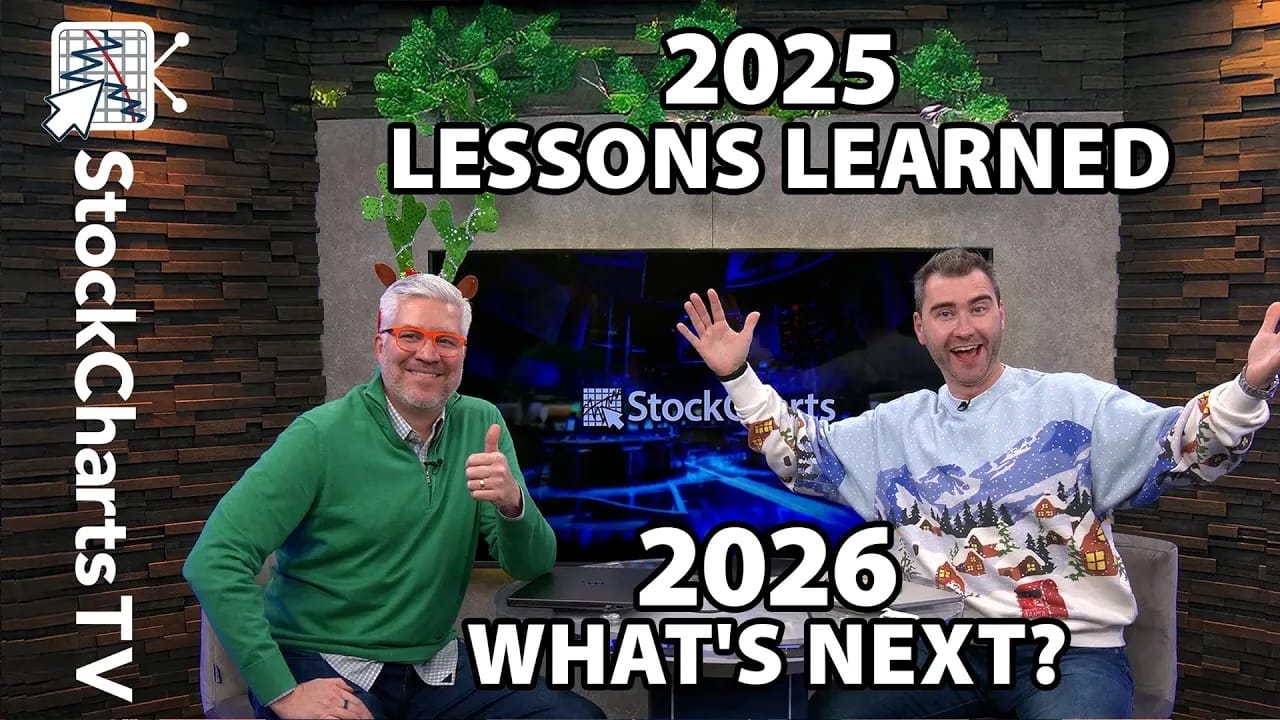DIRECTIONAL MOVEMENT INDICATORS BATTLE IT OUT FOR DIA AND IWM -- SMALL-CAPS LEAD MARKET LOWER AFTER ISM -- BEARISH DIVERGENCES REMAIN FOR KEY BREADTH INDICATOR -- WHAT'S THE DEAL WITH APRIL?
DIRECTIONAL MOVEMENT INDICATORS BATTLE IT OUT FOR DIA AND IWM... Link for todays video. Lots of people are looking for a stock market correction, but it remains elusive as the major index ETFs either consolidate or extend their gains. There is only one thing required for a correction: more selling pressure than buying pressure. Taking this one step further, a correction will not materialize until we see some evidence of selling pressure. How much selling pressure is needed to signal the start of a correction? We can answer that question by looking at the amount of buying pressure required to maintain the current rally and the amount of selling pressure required to trigger the last correction, which was in October-November.
StockCharts.com has three indicator pairs that separate up movements from down movements: the Vortex Indicator, Aroon and Directional Movement. The red lines represent downside movement or selling pressure. The green lines represent upside movement or buying pressure. A basic signal triggers when these lines cross. Chartists can also apply an absolute threshold to confirm signals and reduce whipsaws. In other words, the green line has to cross the red line AND exceed a certain level to trigger a buy signal. Let's put this in practice with Welles Wilder's Directional Movement Indicators.
The Dow SPDR (DIA) was stuck in a small range since March 12th and then edged above resistance over the last two days. The Directional Movements Indicators equalized as trading turned flat and the first indicator to break above 30 will trigger the next signal. Chart 1 show DIA hitting 144 on March 11th and then trading flat the last few weeks. With the medium-term trend clearly up, this looks like a flat flag, which is a bullish continuation pattern. The consolidation lows mark first support. A break below these lows would be short-term bearish and argue for a correction that could extend back to the February consolidation.

(click to view a live version of this chart)
Chart 1
The indicator window shows the Average Directional Index (ADX) along with Plus Directional Movement (+DI) and Minus Directional Movement (-DI). +DI crossed above DI on December 5th and exceeded +30 to kick off the current uptrend. +DI has moved above/below 30 since, but DI has yet to make it above 30. More recently, the indicators converged in the low 20s as directional movement flattened. I am now waiting for one of these to make its move. +DI still has the edge because it was the last one to exceed 30. DI would have to break above 30 to reverse this edge. Looking back to the correction, notice that DI crossed above +DI and above 30 on October 19th. I will look at SPY and MDY with the Vortex Indicator on Wednesday. You can read more about these indicators in our ChartSchool.
SMALL-CAPS LEAD MARKET LOWER ON EASTER MONDAY... Stocks are trading lower on Monday after a weak open and sell off on an ISM miss. The major index ETFs opened weak the Russell 2000 ETF (IWM) bearing the brunt of selling pressure (down over 1.5% near midday). DIA, in contrast, was only down .05% and SPY was down around a half percent. Small-caps are sometimes the canaries in the coalmine so we should watch IWM performance closely. Chart 2 shows IWM testing the mid March lows, even as DIA trades above consolidation resistance. A close below these lows would be the first negative sign. The indicator window show DI turning up and reaching 29 today. DI has not been above 30 since mid November and a break above this level would be negative. I would not, however, use a single signal from IWM to suggest a trend reversal in the stock market. Instead, I would look for confirmation signals from the other major index ETFs (DIA, MDY, QQQ, RSP, SPY). Signals in three of these five would tilt the balance.

(click to view a live version of this chart)
Chart 2
BEARISH DIVERGENCES REMAIN FOR KEY BREADTH INDICATOR... Chartists can also use breadth indicators to look for signs of a trend change in the major index ETFs. The percentage of stocks above the 50-day moving average is a breadth indicator that measures the degree of participation in a move. The 50-day moving average is a medium-term indicator that helps define the trend. In general, the bulls have the edge when more than 50% of stocks are above the 50-day lines, while the bears have the edge when less than 50% are above their 50-day lines. Chartists can also look for trends, support breaks and resistance breaks for signals.
Chart 3 shows the Nasdaq 100 %Above 50-day SMA ($NDXA50R) forming a bearish divergence over the last few months. A bearish divergence forms when the index records a higher high and the indicator fails to confirm. Notice that the Nasdaq 100 ($NDX) moved above 2800 in March, but the indicator did not make it back above 85%. This bearish divergence tells us that fewer stocks participated in the advance from late February to mid March. Notice that over 90% of stocks were above their 50-day moving averages in early February. A bearish divergence alone is not enough to justify a bearish stance (IMHO of course). The December-February lows mark a clear support level at 57%. A break below these lows would signal a downtrend and this would be medium-term bearish for the Nasdaq 100. Notice that bearish divergences and support breaks foreshadowed the last two corrections.

(click to view a live version of this chart)
Chart 3
Those looking for a faster signal (arent we all) can apply MACD (12,26,1) to the indicator. I am using 1 for the signal line because I am only interested in moves above/below the zero line. These crosses are sometimes early, sometimes on time and sometimes a little late. Notice that MACD turned negative in early March 2012 and the market did not break down until April. MACD turned negative in late September and this signal coincided well with the September peak. MACD has been negative since mid February and failed to break back above the zero line in March. It is turning down again and this is the early signal to turn bearish.
Chart 4 shows the S&P 500 %Above 50-day SMA ($SPXA50R) with the same setup. A break below 60% would turn this indicator outright bearish. MACD has already turned bearish with a bounce just above zero and another downtrend. Notice that this sequence looks just like March 2012.

(click to view a live version of this chart)
Chart 4
WHAT'S THE DEAL WITH APRIL?... Even though the S&P 500 has been moving higher since March 2009, the last three Aprils marked peaks that foreshadowed corrections. Chart 5 shows the S&P 500 with weekly bars since October 2010. The trend is clearly up with a series of rising peaks and rising troughs. The yellow areas mark April for each year. Notice that the S&P 500 peaked in April 2010, April 2011 and April 2012. There are two reasons for these peaks. First, the S&P 500 advanced sharply the first quarter of each year and began April with overbought conditions. The S&P 500 advanced over 10% in the first quarter of 2013 and also entered April with overbought conditions. Chartists looking for a number can note that 14-week RSI has been above 70 for three weeks. Second, the six month cycle turns bearish in May (Sell in May and go away). According to the Stock Trader's Almanac, the Dow performs best during the bullish six month cycle (November to April) and worst during the bearish six month cycle (May to October). As suggested in the prior analysis, overbought conditions and bearish cycles are not enough to actually turn bearish. We need some sort of trigger that signals an increase in selling pressure. Another such trigger would be the weekly MACD Histogram turning negative, which occurs when the weekly MACD line moves below its signal line.

(click to view a live version of this chart)
Chart 5
KEY INDUSTRY GROUPS WITHIN THE MATERIALS SECTOR EXTEND DOWNTRENDS... The industry groups within the materials sector have been and remain the weakest in the stock market this year. The S&P 500 is up over 10% year-to-date, but these five industry groups within the materials sectors are down double digits this year. Chart 6 shows a PerfChart with the Copper Miners ETF (COPX), Gold Miners ETF (GDX), Metals and Mining ETF (XME), Silver Miners ETF (SIL) and Steel ETF (SLX). The silver and gold miners are leading the way with losses approaching 20%. Note that data for Monday has yet to be added, which means losses are even greater.

(click to view a live version of this chart)
Chart 6
PRICE RELATIVES HIT NEW LOWS FOR COPX, XME AND SLX... Chart 7 shows the Copper Miners ETF (COPX) peaking in January and trending lower this year. The price relative broke its summer lows and forged a 52-week low in March. Chart 8 shows the Metals and Mining ETF (XME) breaking down in February, bouncing in mid March and then continuing lower with a move below 40 today. The price relative hit a 52-week low today. Chart 9 shows the Steel ETF (SLX) plunging over 1% on Monday. The indicator window shows the price relative trending lower since January 2nd.

(click to view a live version of this chart)
Chart 7

(click to view a live version of this chart)
Chart 8











